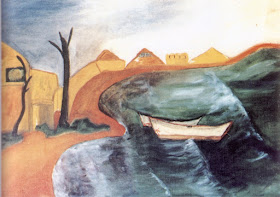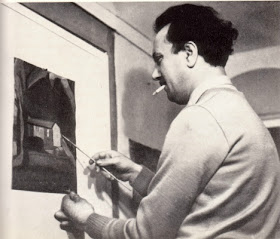
Over a period of ten months from May 1883 through to March 1884 Elihu Vedder completed a series of some fifty four drawings which illustrated the 1884 edition of Fitzgerald's Rubaiyat. These drawings are rightly considered his masterwork and the Vedder-Fitzgerald Rubaiyat is regarded as the pinnacle of late Victorian artist book design. It is a magnificent work in every respect, a masterpiece of orientalist literature, a moment in time when the orientalist genius reached its acme. Not since the work of William Blake had illustration and poetic text come together in such a profound synthesis. Indeed, Vedder's drawings bear comparison with those of Mr. Blake in their visionary strength. Fitzgerald's renderings of Khayyam into English verse are very fine, albeit seeming somewhat antiquated and stolid nowadays, but Vedder's accompanying illustrations are sublime and luminous and enduring. The book as a whole stands as a single work and needs to be appreciated as such, but here are some samples:

His later work shows a stronger debt to the classicizing styles of such painters as Lawrence Alma-Tadema and Edward Burne-Jones. Here is one of his best known mythological works, the Sibyll Coming to Rome.

What is depicted here is the Sibyll from Cumae clutching her scrolls of prophecy and making out on the road to Rome with ancient determination. Living in Italy, Vedder was familiar with the archeaological remnants of Cumae and it was natural that the ancient prophetess should feature in his visionary art. He rendered this image in other forms too. The painter was completed in Rome is 1876. He made the following drawing in 1872:
Here is another of his paintings on the subject of the Cumae Sybill:
Perhaps his most famous and arresting image, again prophetic and symbiline in spirit, is the following:
It is entitled Listening to the Sphinx or else The Questioner of the Sphinx. It is often reproduced in various contexts today, sometimes erroneously with the title Ozymandiaz after the poems by Horace Smith and Percy Shelley. It is remarkable in the way that it shows a further motivation in the orientalist spirit - a need and a willingness to listen to the distant past, as against the arrogant ignorance of modernity. Europeans turned to the East in search of the ancient and the authentic, as a reaction to modernity. This painting by Mr Vedder is one of the most powerful and haunting renderings of such a spirit. It was this spirit that led Vedder to Egypt on a journey up the Nile on a traditional Egyptian houseboat from December 1889 to April 1890, just as it has led countless others to seek some whisper, some omen, from Egyptian antiquity.
The image and the idea of the sphinx reoccurs in his work in the same way as the sibyl. Here is one study made after his Egyptian sojourn:

And here is a further example entitled The Sphinx on the Seashore:
He left a detailed visual record of his Egyptian travels, not only in completed paintings but in a large number of sketches. An example:
* * *
There are too many great and wonderful works by this artist for us to consider even the most notable of them here. The following are a few that stand out in the present writer's estimation, but there are many others:


















































